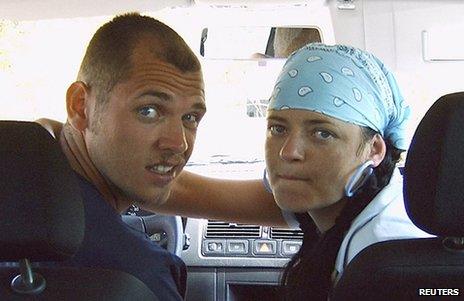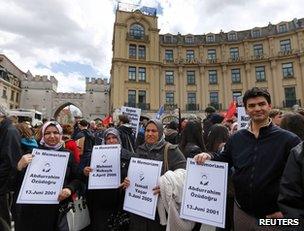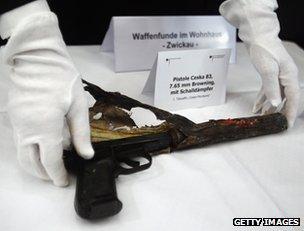German neo-Nazi trial shrouded in intrigue
- Published

Uwe Boehnhardt (L) and Beate Zschaepe are seen here in an undated photo
One of the biggest trials in Germany since the war focuses on an alleged neo-Nazi ring.
She has the sweetest face. Beate Zschaepe smiles gently at the camera as she twirls for the video the police made for their files. She is dressed in a girlish pink top as she performs the required choreography shortly after giving herself up. It is a face of child-like innocence, a young woman who would not hurt a fly.
But is it the face of genuine innocence - or a deceptive face concealing her involvement in the murder of 10 truly innocent people?
Prosecutors have called Beate Zschaepe the country's most dangerous neo-Nazi. She is accused of helping to murder nine men, all but one of them of Turkish background, and a policewoman.
She is also accused of helping in 28 attempted murders as well as being a member of a terrorist organisation. And she is charged with robbery, causing explosions and arson.
The arson relates to the fire which she is alleged to have started before giving herself up on 8 November 2011, telling police she was the one they were looking for.

Campaigners say there needs to be a broader investigation into the crimes
She shared a flat in Jena, in the old East Germany, with two men - Uwe Boehnhardt und Uwe Mundlos. They had been found shot dead four days earlier, apparently a double suicide after they botched a bank robbery.
After the deaths, the gun used in the murders of the 10 people was discovered, thus clearing up one mystery but opening another: how did they get away with it for so long?
And it opened a debate about whether the police and security services were "blind in the right eye" because they had failed to see right-wing terrorism. And there was even speculation that maybe they had detected it through informers but then failed to act on it out of sympathy.
Families' ordeal
The first murder took place at a stall on the outskirts of Nuremberg on the Saturday afternoon of 9 September, 2000.
Two gunmen shot a seller of flowers in the face. They fired eight shots at Enver Simsek, six of which hit him. Two days later he died in hospital. One of the weapons used was a Czech-made pistol - a CZ 83 - the gun found after Beate Zschaepe handed herself in 11 years later.
The pattern of that first murder was repeated over the next six years. The victims were Turkish except for Theodoros Boulgarides, a locksmith who may have been mistaken for a Turk. The last murder was that of a policewoman on 25 April, 2007. Nobody - except perhaps Beate Zschaepe - knows the motive for this murder, though it may have been a personal grudge or an attempt to get weapons.
Either way, after the double suicide and Ms Zschaepe's surrender, a grisly video emerged (some say sent by the woman now on trial) which gloated over the killings. To the tune of the Pink Panther, it showed pictures of the corpses of the victims and identified the "organisation" behind the murders as the National Socialist Underground.
It was a revelation to the police. They had initially assumed that the murders were the work of the Turkish mafia. This meant that the families of the victims had been interrogated, in their grief, as potential perpetrators rather than as victims themselves. In one case, a mother who had scrubbed and cleaned up her own son's murder scene then found herself the object of suspicion.
Mehmet Daimagueller, who represents one of the families, still seethes with anger. He told the BBC: "It's obvious you can't survive underground in Germany - you need to have people supporting you - and I would like to know who supported the group."
He is voicing a common discontent about the trial in Munich. It is, the critics say, about much more than the specific charges against one woman.
This police video shows alleged neo-Nazi Beate Zschaepe in an identity parade.
Multiple agencies
Big questions arise because of the failure of the security authorities. The neo-Nazi trio were known to have been involved in far-right demonstrations 20 years ago in Jena, the run-down town where they got to know each other as rebellious teenagers.
One case cited is where a doll bearing the sign "Jew" was hung from a motorway bridge. The three realised they were known to the authorities so, it is alleged, they vanished from view in 1998 to found their murderous cell.
One of the problems for the authorities is that they have admitted that documents relating to the investigation were shredded. The questions asked by sceptics are: did informers tell the authorities of the activities of this group and, if so, why were the murders not halted?
The authorities' defence is that law enforcement in Germany is in the hands of myriad agencies, police and secret service, national and local.
On top of that, the murders were spread out in place and time. Sometimes the killers would strike within a few weeks of the previous murder and sometimes many months would pass.

The gun used in the murders was recovered
Even today, it is hard to see why these particular victims were chosen. They were invariably the operators of small businesses - tailors, internet cafes, a flower stall, kebab shops - with no public profile. Their shops were nondescript and often in run-down parts of a city. The murders were spread across Germany in no particular pattern.
'Never again'
One of Germany's leading investigative authors, John Goetz, wrote a book on the case. He concluded that it was more cock-up than conspiracy.
"What we are looking at is security services which failed dramatically but basically out of incompetence and pettiness, not out of Nazi sympathies," he told the BBC.
On this view, the shredding of documents was to protect the security services from embarrassment over incompetence rather than to hide their complicity.
Sebastian Edathy, who heads a German parliamentary investigation, inclines to a similar view but thinks there was a blindness to the crimes of the right - the police simply assumed that Turkish victims meant Turkish criminals.
The Bundestag, he said, was debating new legislation which would oblige police to investigate a possible political background to any severe crime where the victim was a member of a religious or ethnic minority.
"Right-wing extremism should never be underestimated again in Germany," he added.
- Published29 November 2011
- Published15 November 2011